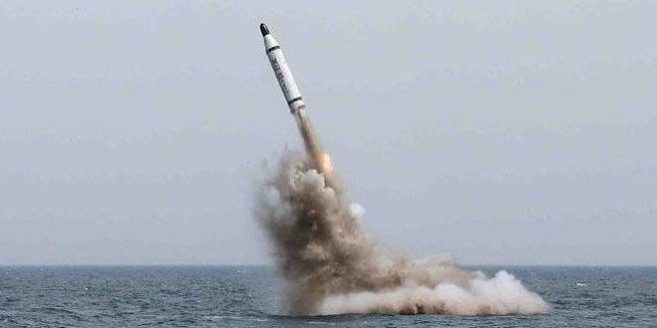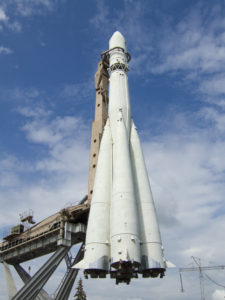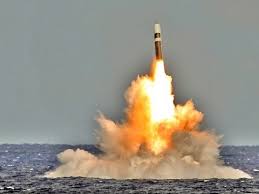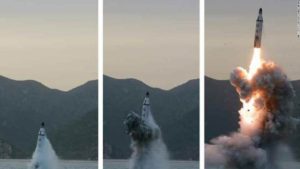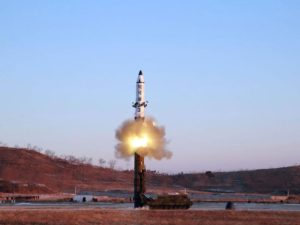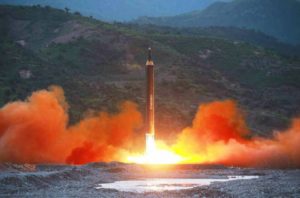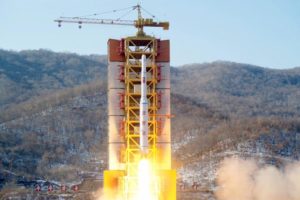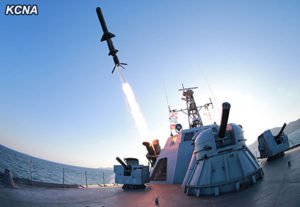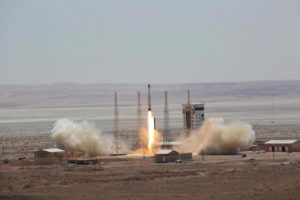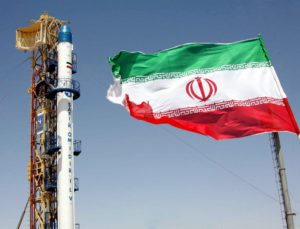Germany
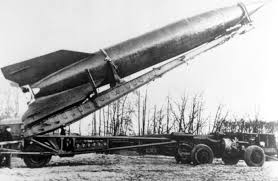
The V-2 Rocket
- Late 1930s and early 1940s: The V-1, also known as the “flying bomb”, was tested by Nazi Germany. The V-1 operated similarly to a modern day cruise missile. Germany launched a limited number of the V-1s during World War II.
- October 1942: The V-2, the first long-range ballistic missile, was successfully tested by Nazi Germany. Throughout the Second World War, Germany employed the V-2 to launch strikes on targets throughout Western Europe, including London.
Russia
- August 1957: Russia claims to have successfully tested The R-7, the first Intercontinental-range Ballistic Missile (ICBM).
- October 1957: Sputnik is successfully put into orbit using a long-range rocket.
- August 1957: Burya, a long-range cruise missile flies for the first time.
- February 1961: The R-16 ICBM flies its first test mission.

The R-7 Based Rocket
- January 1965: The R-36 ICBM is launched from silo for the first time.
- February 1966: Russia’s first solid fueled ICBM, the RT-2, flies its first test mission.
- October 1967: The first RT-20P mobile ICBM is launched. A large number of launches were unsuccessful.
- December 1976: The first Soviet submarine launch of a solid propelled missile takes place.
- January 1984: The first railroad-based RT-23 ICBM (version 15Zh52) is tested.
- December 1994: Topol-M ICBM flies its first test mission.
- 1996: Iskander short-range missile is launched for the first time.
- April 1998: R-36M2 ICBM with 10 MIRV warheads successfully strikes all of its targets during test.
- July 2001: The R-29RL carrying the solar-sailing spacecraft launched from a submerged nuclear submarine.
- December 2004: The Topol-M ICBM is launched from a mobile launcher.
- May 2007: the RS-24, which is capable of carrying multiple warheads flies a test mission.
- July 2014: the SSC-8, a missile violating the INF Treaty is tested for the first time.
- December 2018: The Avangard hypersonic glide vehicle (HGV) is tested.
- February 2022: Russia conducted nuclear and conventional weapons drills with Belarus which featured numerous ballistic, cruise and hypersonic missiles launched from land, sea and air platforms.
- April 2022: Russia conducted its first flight test of the RS-28 Sarmat intercontinental ballistic missile
- May 2022: Russia tested its Zircon hypersonic missile in a launch from an Admiral Gorshkov frigate in the Barents sea. The missile traveled approximately 540 miles and struck its target in the White Sea.
The United States
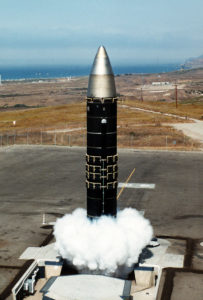
The Peacekeeper MX missile
- April 1946: The first A-4 (V-2) was fired from white sands in New Mexico.
- July 1948: The first MX-774 was unsuccessfully test fired.
- March 1957: The first Jupiter IRBM was unsuccessfully tested.
- September 1957: Thor IRBM fails during launch attempt.
- December 1957: The Atlas ICBM flies its first successful test mission.
- January 1958: A prototype of Polaris A-1 submarine-launched missile flew the first test.
- January 1958: Jupiter rocket launches the Explorer-1, the first U.S. satellite.
- February 1959: Titan I missile was successfully tested.
- September 1959: The minuteman I (America’s first solid-fueled) ICBM was successfully tested.
- June 1960: The Polaris A-1 SLBM becomes the first solid-fueld missile to be launched from a submerged submarine, the USS George Washington.
- May 1962: The first submarine-launch of a live nuclear-tipped missile takes place.
- April 1969: The minuteman III launches from a silo for the first time.

A Trident is launched from a US Submarine
- August 1970: The new Poseidon C-3 ICBM is successfully launched from a submerged submarine.
- January 1977: The first Trident I C-4 SLBM flies a test mission from a surface pad.
- April 1979: Trident I flies its first test mission from a submerged submarine.
- June 1983: The MX peacekeeper ICBM is tested.
- October 1987: The first Small ICBM (SICBM) (Midgetman) is tested.
- November 17, 2011: The first test of a hypersonic weapon, the Advanced Hypersonic Weapon is conducted, successfully traveling from the Pacific Missile Range in Hawaii to the Reagan Test Site at Kwajalein Atoll in the Marshall Islands in under 30 minutes.
- August 24, 2014: A second test of the Advanced Hypersonic Weapon from the Kodiak Launch Complex in Alaska was terminated shortly after launch due to an anomaly in the launch vehicle.
- October 30, 2017: An intermediate-range test of a new hypersonic missile was conducted to gather data on hypersonic boost-glide technologies and was reported as a success by the Pentagon.
- July 12, 2022: The US Air Force and Defense Advanced Research Projects Agency (DARPA) announced that the Pentagon carried out 2 successful hypersonic systems tests. The AGM-183A Air-launched Rapid Response Weapon (ARRW) had its second successful test on July 12, after a series of testing failures. The ARRW is a boost-glide system that uses a rocket to accelerate a missile to hypersonic speeds. Afterward, it releases a hypersonic glider that coasts toward the target at speeds in excess of Mach 5.
North Korea
Hwasong-17
- May 25, 2022: North Korea fired its Hwasong-17 ICBM, North Korea’s largest known ICBM, alongside two short range ballistic missiles. Hours after President Biden concluded his trip to Asia, the ICBM traveled 223 miles at an altitude of 335 miles, the second launch was unsuccessful, and the third missile flew 472 miles at a height of 37 miles.
KN-23
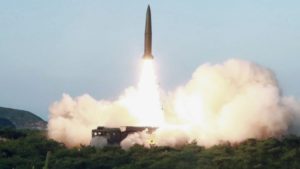
The KN-23 test fired for the first time on May 4, 2019.
- July 24, 2019: North Korea tested the SRMB at an extended range compared to previous tests. One missile flew 690 km and the other 430 km. Both missiles had an apogee of 50 km and landed in the East Sea.
- May 9, 2019: North Korea tested two KN-23 missiles. The first had a range of 420km and the second of 270 km – both of an apogee of 50 km.
- May 4, 2019: North Korea tested the KN-23 for the first time. The test was conducted from Wonsan and had a range of 240 km and an apogee (maximum height on the ballistic rectory) of 60 km.
KN-22 (Hwasong-15)
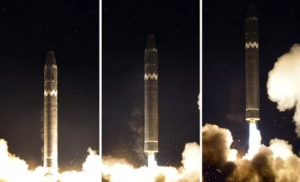
The first successful test of the Hwasong-15 on November 29, 2017.
- November 29, 2017: This test marked the first successful test of North Korea’s newest ICBM. The missile reached an altitude of 4,475 km, flew for 53 minutes, and traveled 950 km. According to these results, the Hwasong-15 could theoretically hit the entire continental United States.
- March 24, 2022: North Korea has fired what is believed to be its first intercontinental ballistic missile (ICBM) in more than four years, the Hwasong-15 alongside two other SRBM’s. The suspected ICBM flew to an altitude of 6,000 kilometers (3,728 miles) and to a distance of 1,080 kilometers (671 miles) with a flight time of 71 minutes before splashing down in waters off Japan’s western coast. Initial reports that the missile test featured a Hwasong-17, North Korea’s newest ICBM were debunked by South Korean and U.S. analysis.
KN-21
- August 26, 2017: The KN-21 is suspected to be a variant of North Korea’s first missile, the Hwasong-5 (Scud-B). North Korea launched three KN-21s in 10-minute intervals. The second missile blew up immediately after launch, but the first and third missiles flew around 250km before falling into the sea.
KN-20 (Hwasong-14)
-

The first successful test of the Hwasong-14 on July 4, 2017.
July 28, 2017: The second successful test on an intercontinental ballistic missile (ICBM) by North Korea. The missile reached an altitude of 3,700 km, flew for 47 minutes, and travelled 988 km before landing in the Sea of Japan.
- July 4, 2017: The first successful test of an ICBM by North Korea. The missile reached an altitude of 2,802 km and travelled 933 km before landing in the Sea of Japan.
KN-11 (Polaris-1, Pukkuksong-1)
- August 24, 2016: A KN-11 launched from a sub-surface submarine and travelled 500 km.
- July 9, 2016: A KN-11 was launched and reached an altitude of 10 km before exploding.

April 23, 2016 test launch of North Korea’s KN-11 SLBM.
- April 23, 2016: Test launch of a solid-fuel SLBM in the Sea of Japan.
- April 8, 2016: Test launch of an SLBM.
- March 16, 2016: Land-test of the KN-11 SLBM.
- December 21, 2015: Failed test launch of the KN-11 SLBM. Was reported as a successful launch by North Korea after its fourth nuclear explosion test in January 2016.
- November 28, 2015: Failed test launch of the KN-11 SLBM.
- May 8, 2015: Test launch of the KN-11 SLBM from a submersible barge.
- April 22, 2015: Test launch of KN-11 SLBM reported by 38 North.
- January 23, 2015: Flight test of the KN-11 from a sea-based platform.
- December 21, 2014: Test launch of the KN-11.

First test launch of the Polaris-2 on February 12, 2017.
Polaris-2 (Pukkuksong-2/KN-15)
- May 21, 2017: The second test of the Polaris-2. The missile reached an altitude of 560 km and flew around 500 km before falling into the Sea of Japan.
- February 12, 2017: The first test of the Polaris-2, that was cold-launched from a tracked TEL. The missile reached an altitude of 550 km and flew east for 500 km before falling into the Sea of Japan.
No-Dong
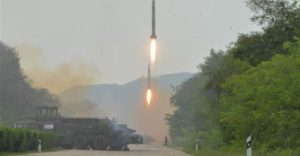
Two of the three No-Dong missiles launched on September 5, 2016.
- September 5, 2016: Three No-Dong missiles launched from TELs, each traveling around 1,000 km.
- August 3, 2016: Two No-Dong missiles launched from TELs. One exploded shortly after launch, but the second landed in the sea within Japan’s exclusive economic zone.
- July 19, 2016: One No-Dong and two Scud missiles launched from TELs.
- March 18, 2016: Two medium-range missiles, believed to be No-Dong, were launched from TELs and flew about 800 km.
- March 25, 2014: Two No-Dong missiles were launched and travelled almost 650 km before landing in the sea.
- July 4, 2009: Believed to have launched two No-Dong and five Hwasong-6 missiles that each flew about 420 km.
- July 5, 2006: Six missiles were launched, one was the Taepodong-2 and the other five were believed to be a mixture of No-Dong and Hwasong-6 missiles.
- May 29, 1993: First successful test launch of two No-Dong missiles that travelled about 550 km.
- May 1990: Failed flight test of the No-Dong.
Musudan
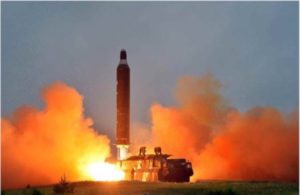
North Korea’s first successful test launch of the Musudan missile on June 22, 2016.
- October 20, 2016: Another failed test of the Musudan that took place in Kusong. A U.S. expert, Jeffrey Lewis, stated the test could have potentially involved the KN-08.
- October 14, 2016: Failed launch took place in Kusong. Projectile exploded right after launch. A U.S. expert, Jeffrey Lewis, stated the test could have potentially involved the KN-08.
- June 22, 2016: Successful launch of two Musudan missiles. One travelled 400 km after reaching an altitude of over 1,000 km.
- May 31, 2016: Fourth failed launch attempt of the Musudan missile.
- April 28, 2016: Failed launch attempt of two Musudan missiles.
- April 15, 2016: First launch attempt of a Musudan missile that ended in failure.
Hwasong-12 (KN-17)
-

First successful launch of the Hwasong-12 on May 14, 2017.
September 15, 2017: North Korea launched a third successful test of the Hwasong-12, which once again flew over the northern tip of Japan, Hokkaido. The missile flew over 3,700 km and reached an altitude of 770 km before landing in the Pacific Ocean.
- August 29, 2017: North Korea launched a second successful test of the Hwasong-12, which flew over the northern tip of Japan, Hokkaido. The missile reached an altitude of 550 km and traveled over 2,700 km before breaking apart and landing in the Pacific.
- May 14, 2017: The first successful launch of the Hwasong-12. The missile reached an altitude over 2,000 km and travelled 787 km before landing in the Sea of Japan. North Korea stated the missile tested and verified the country’s capability to carry “a large size heavy nuclear warhead,” and the reentry vehicle’s ability to survive reentry.
- April 29, 2017: A test launch of the KN-17 missile that was assessed to be a failure. It was reported the missile only traveled about 35 km.
- April 16, 2017: Believed to be the second attempted launch of the Hwasong-12 ballistic missile. The missile exploded shortly after launch.
- April 5, 2017: Believed to be the first attempted launch of the Hwasong-12 ballistic missile. The test is believed to have ended in failure after the missile traveled 60 km before it spun out of control and crashed into the Sea of Japan.
Hwasong-5 (Scud-B Variant)
- July 26, 2014: Test launch of a Scud missile that travelled about 500 km, likely the Hwasong-5 short-range missile.
- July 13, 2014: Test launch of two, likely, Hwasong-5 missiles.
- July 9, 2014: Test launch of two Hwasong-5 missiles.
- June 29, 2014: Test launch of two Hwasong-5 missiles.
- March 3, 2014: Test launch of two short-range missiles that travelled about 500 km, like the Hwasong-5.
- February 27, 2014: Test launch of four short-range missiles that flew about 200 km and are believed to have been Hwasong-5 missiles.
- April and September 1984: Six Hwasong-5 missiles, three in April and three in September, were the first confirmed flight tests and are reported to have had a 50% success rate.
- April 1982: First reported flight test of an “indigenously modified Scud”.
Hwasong-6 (Scud-C Variant)
- July 19, 2016: Two Scud and one No-Dong launched from TELs.

July 19, 2016 test launch of two Scud-Cs and one No-Dong missiles.
- March 10, 2016: Launched two short-range missiles, believed to be Scuds, and flew about 500 km.
- July 4, 2009: Test launched five Hwasong-6 and two No-Dong missiles that each flew about 420 km.
- July 5, 2006: Six missiles were launched, one was the Taepodong-2 and the other five were believed to be a mixture of Hwasong-6 and No-Dong missiles.
- June 1991: Hwasong- 6 missile launched.
- June 1990: First reported successful flight test of the Hwasong-6.
- May 1986: First test launch of the Hwasong-6.
Hwasong-7 (Scud-D)
- May 29, 2017: A version of the Scud-D (Scud-ER) was reported to have been launched and travelled around 450 km before landing in the Sea of Japan. North Korea stated the missile test was meant to demonstrate a new maneuverable reentry vehicle.
- March 6, 2017: Four Scud-D (Scud-ER) ballistic missiles were launched flying over 1,000 km.
KN-21 (Scud-B Variant)
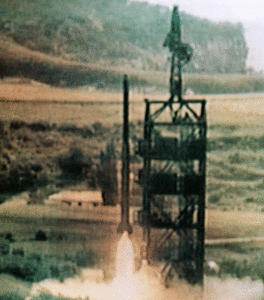
1998 launch of the Taepodong-1 missile.
- August 25, 2017: Launch of 3 short-range ballistic missiles (SRBMs). Experts believe this test showcased a new modification to their oldest missile, the Hwasong 5 (Scud B). The United States has designated this new missile as the KN-21. The second missile blew up immediately after launch, but the first and third missiles flew around 250km before falling into the sea.
Taepodong-1
- August 31, 1998: The only launch of this missile that North Korea claims placed a satellite into orbit, but this is disputed by the international community.
Taepodong-2 (Unha-3)
- February 7, 2016: The space-launch version, the Unha-3, successfully placed the Kwamongsong-3 satellite into orbit.
- December 12, 2012: The space-launch version, the Unha-3, successfully placed the Kwamongsong-3 satellite into orbit.

Launch of the Taepodong-2 on February 7, 2016.
- April 12, 2012: Failed launch of the space-launch version, called the Unha-3.
- April 5, 2009: Test launch of the Taepodong-2, in a space-launch configuration, called the Unha-2, that travelled around 3,800 km and landed in the Pacific Ocean east of Japan.
- July 5, 2006: First attempt to launch the Taepodong-2 missile that failed 40 seconds into its flight. Five other missiles were also launched believed to be a mixture of Hwasong-6 and No-Dong missiles.
Anti-Ship Cruise Missiles
- June 14, 2015: Launch of three KN-01 anti-ship cruise missiles.
- May 9, 2015: Launch of three KN-01 anti-ship cruise missiles.

North Korea’s Feb. 7, 2015 test launch of the KH-35.
- February 7, 2015: Test launch of the Russian KH-35 anti-ship cruise missile, Kim Jong-un attended the test.
- July 2, 2009: Believed test launch of four KN-01 short-range cruise missiles.
- June 7, 2007: Believed test launch of two short-range anti-ship cruise missiles.
- April 1, 2003: Conflicting reports of a test launch of a short-range anti-ship cruise missile.
- March 10, 2003: Test launch of a short-range anti-ship cruise missile.
- February 25, 2003: Test launch of an anti-ship cruise missile.
- May 31, 1994: Test launch of a new anti-ship cruise missile.
KN-02 Toksa
- April 2 & 3, 2015: Reported four Toksa missiles were launched over the two days.
- February 8, 2015: Five short-range missiles, believed to be KN-02s, were launched off the eastern coast.
- August 14, 2014: Test launch of five short-range missiles believed to be KN-02 missiles.
- May 20, 2013: Test launch of two short-range missiles, believed to be KN-02 missiles.
- March 16, 2013: Test launch of two short-range missiles, believed to be KN-02 missiles.
- February 10, 2013: Believed test launch of a short-range KN-02 missile.
Miscellaneous (Not Identified)
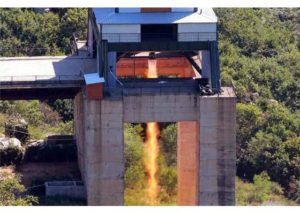
September 20, 2016 North Korean rocket engine test
- March 12, 2023: Claimed to launch two strategic cruise missiles from a submarine into the Sea of Japan, however South Korea says that only one was fired.
- June 8, 2017: Reported to have launched several land-to-ship missiles off the east coast. They are believed to have traveled about 200 km.
- March 24, 2017: Ground test of a rocket engine.
- March 22, 2017: Failed test launch of an unidentified missile.
- March 18, 2017: Ground test of a rocket engine.
- September 20, 2016: Ground test of the largest rocket engine to date.
- April 9, 2016: Ground test of a large liquid-fuel engine designed for an ICBM.
- April 1, 2016: Fired a short-range surface-to-air missile.
- March 29, 2016: Test fired a short-range missile off the east coast that flew 200 km.
- March 22, 2016: Ground test of a solid-fuel engine.
- March 21, 2016: Fired five projectiles into the sea from the east coast.
- Early August 2015: Believed at least one test of a rocket engine.
- September 6, 2014: Test launch of three short-range missiles, each traveling over 200 km.
- September 1, 2014: Launch of a short-range missile that flew over 215 km.
- June 27, 2014: Test launch of three short-range missiles that travelled around 200 km.
- Early August 2014: 38 North reports a suspected engine test of the 1st stage of KN-08 missile.
- Early June – Early July 2014: 38 North reports a suspected engine test of the KN-08 missile.
- Late March – Early April 2014: 38 North reports a suspected engine test of the KN-08 missile.
- March 22 – 23 2014: Reported test launch of 46 short-range rockets in the two days.
- March 17, 2014: Reported test launch of 25 short-range rockets.
- December 2013 – Early January 2014: 38 North reports a suspected long-range rocket engine test.
- Late August 2013: 38 North reports a suspected long-range rocket engine test.
- May 19, 2013: Two short-range projectiles launched off east coast.
- May 18, 2013: Two short-range projectiles launched off east coast.
- Late March – Early April 2013: 38 reports a suspected rocket engine test.
- May 26, 2009: Three short-range missiles launched. The missiles were believed to be anti-ship and surface-to-air missiles.
Iran
Scud-C Variant (Shahab-2)
- February 10, 2014: Successful test launch of a Qiam-1 missile.
- August 2010: successful test launch of the liquid-fueled Qiam-1 missile.
- May 1991: Test-fires Scud-C purchased from North Korea.
Shahab-3
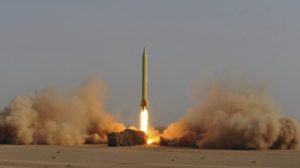
Launch of an Iranian Shahab-3
- July 24, 2019: Successful test-firing of Shahab-3 missile. The missile traveled 1,100 km and stayed within Iranian territory for the duration of the flight.
- November 21, 2015: Successful test of Ghadr-1 missile.
- July 2012: Successful test-firing of Shahab-3 missile.
- July 2008: claims to have successfully test-fired a Shahab-3 missile.
- December 2004: Initial testing of Ghadr-1, a modified Shahab-3.
- October 20, 2004: Successful test of Shahab-3 variant, Shahab-3M.
- August 11, 2004: Successful test of Shahab-3 variant, Shahab-3M.
- July 7, 2003: Successful test of Shahab-3 missile.
- July 2002: Two tests of Shahab-3 missile, first is unsuccessful, second is successful.
- May 2002: Successful test of Shahab-3 missile.
- September 21, 2000: Test-firing of Shahab-3D motor, disputed as to its success.
- July 15, 2000: Successful test of Shahab-3 missile.
- July 22, 1998: First test flight of Shahab-3 missile, partially successful.
Sejil Missile Systems (Solid-Propellant Variant of Shahab-3)
- February 2011: Iran successfully test fires the Sejil-2 missile.
- October 2010: Successful test firing of Sejil missile.
- December 16, 2009: Iran successfully test-fires an upgraded version of the Sejil-2.
- September 28, 2009: Unsuccessful test of the Sejil-2 missile.
- May 20, 2009: Iran successfully test fires the Sejil-2 missile.
- November 2008: First successful test of the Sejil missile system.
- November 2007: Initial version of Sejil missile, Ashura, test-fired unsuccessfully.
- May 2005: Iran successfully completes test-firing of Shahab-3D solid-propellant motor.
Anti-Ship and Cruise Missiles
- May 2, 2017: test launch of Jask-2 cruise missile is unsuccessful in Iran’s first underwater test launch.
- February 27, 2017: Nasir and Dehlaviyeh missiles tested during a naval exercise.
- January 29, 2017: First known flight test of Soumar cruise missile ends is a success.
- January 2012: Iran test fires Qader, and Nasr missiles during a naval exercise.
- February 2011: tests a supersonic, anti-ship ballistic missile, called the Khalij Fars.
- 1996: Test-fires a Chinese-built C-802 surface-to-surface cruise missile.
- June 1997: reportedly Test fires two Chinese-built C-801K.
Emad
- October 2015: Successfully test fired the Emad (Pillar) missile.

July 27, 2017 test launch of the Simorgh SLV.
Simorgh (Space-Launch Vehicle)
- January 15, 2019: An attempt to place a Payam-e Amirkabir satellite into orbit failed.
- July 27, 2017: Successful test launch of the Simorgh SLV.
- April 19, 2016: Test launch of the Simorgh SLV, that failed to reach orbit.
Safir Rocket (Shahab-3 Satellite-Bearing Variant)
- February 06, 2019: Iran failed to launch a Dousti microsatellite into orbit using a Safir rocket. This was the second failed satellite launch of two attempts in 2019.
- February 2, 2015: Iran launches Fajr satellite using Safir rocket.

An Iranian Safir space-launch vehicle.
- February 2012: Iran successfully launches the Navid satellite into orbit.
- June 2011: Iran launches the Rasad satellite into space using the Safir rocket.
- February 2009: Iran successfully launches the “Omid” telecommunications and research satellite using the Safir 2 rocket.
- February 4, 2008: claimed to have successfully launched its Kavoshgar-1 rocket into space.
Mehrab Missile
- January 2012: Iran test-fires Mehrab missile during a naval exercise.
Surface-to-Surface Missiles
- September 2016: successful test of the Zolfaghar missile.
- August 22, 2015: successful test launch of the Fateh-313 missile.
- August 2012: reportedly test-fires a fourth generation Fateh-110 ballistic missile.
- September 2006: claims to have successfully tested a radar-evading missile called the Sagheb.
- July 16, 2006: Fajr-3 missile exported to Hezbollah kills eight in Haifa.
- May 31, 2001: First successful test of Fateh-110 missile.
Musudan (BM-25)
- July 11, 2016: Test launch of Musudan missile fails after missile explodes shortly after launch.
- April 25, 2016: successful test launch of Musudan missile from North Korea.
Khorramshahr (Musudan Variant)
- January 29, 2017: Khorramshahr variant missile explodes mid-flight during test launch.
Hoveizeh
- January 29, 2019: Iran unveiled the new Hoveizeh long-range cruise missile and showed footage from an undated successful test launch of the missile.
China
DF-ZF
- January 9, 2014: The first test of China’s hypersonic glide vehicle is conducted successfully.
- August 7, 2014: The second DF-ZF test is conducted and is believed to have failed by some experts.
- December 2, 2014: The DF-ZF HGV is successfully tested.
- June 7, 2015: The fourth test of the DF-ZF is conducted and reported as a success.
- August 19, 2015: The fifth test of the DF-ZF is completed, marking the fourth successful test.
- November 23, 2015: The sixth test of the DF-ZF is successful.
- April 22, 2016: The seventh test of the DF-ZF HGV is conducted successfully.
DF-17
- November 2017: Two tests of the DF-17 medium-range ballistic missile with an HGV were conducted. During the first test, the HGV flew at an altitude of 60 km following the ballistic trajectory and reentry of the missile.
- July 27th, 2021: The Chinese military used a “fractional orbital bombardment” to launch a nuclear-capable hypersonic missile for the very first time. The hypersonic missile was suspected of being a DF-17.
- August 13th, 2021: The Chinese military tested its second nuclear-capable hypersonic missile (expected to be a DF-17). Former outgoing vice chairman of the Joint Chiefs of Staff General John Hyten said that the missiles “went around the world, dropped off a hypersonic glide vehicle that glided all the way back to China, that impacted a target in China.” Launched from a rocket in low-Earth orbit, the hypersonic missiles could have evaded the U.S.’ missile defense systems.
Starry Sky-2 (Xing Kong-2)
- August 3, 2018: The first reported test of the Starry Sky-2 hypersonic waverider is conducted. The first test of a vehicle using waverider technology, the Starry Sky-2 reached a top speed of Mach 6 (7,344 km/r).
JL-3
- November 2018: The first test of the JL-3 solid-fuel submarine-launched ballistic missile.

